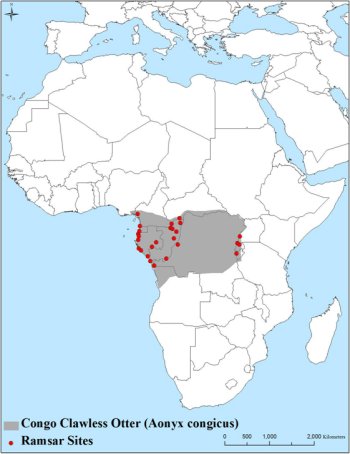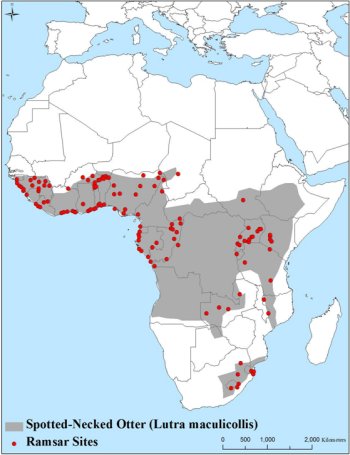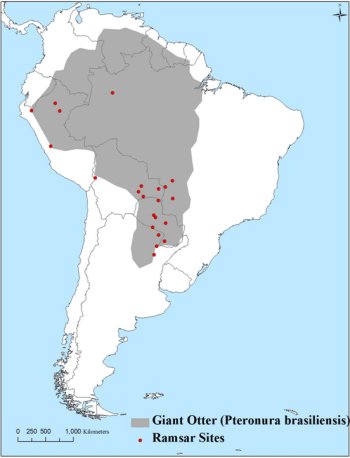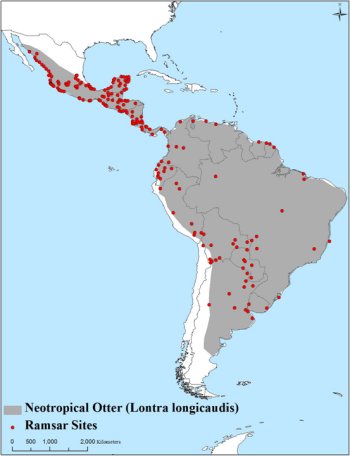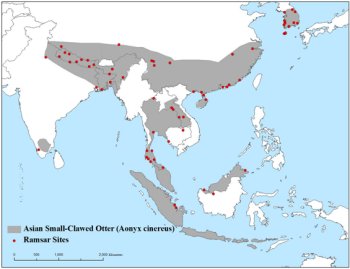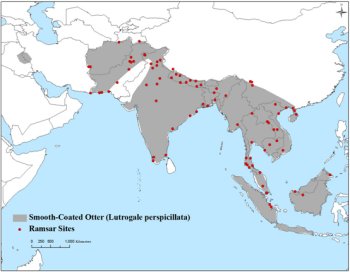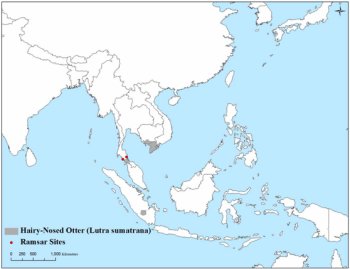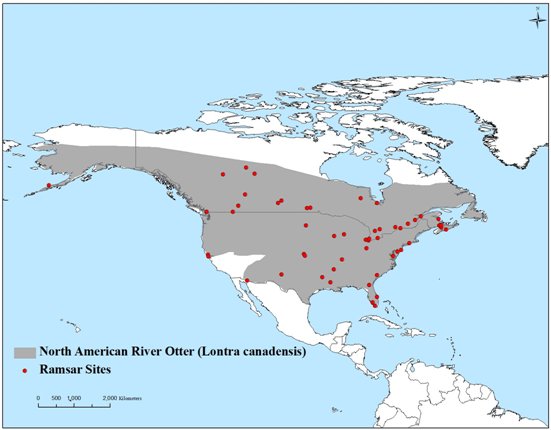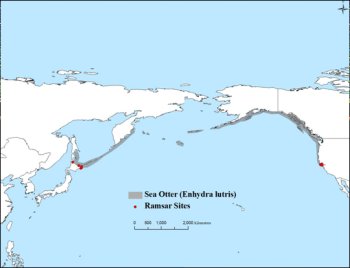IUCN/SSC Otter Specialist Group Bulletin

|
©IUCN/SCC Otter Specialist Group Citation: Brooks, R.P., Serfass, T.L., Triska, M. and Rebelo, L-M. (2011) Ramsar Protected Wetlands of International Importance as Habitats for Otter. Proceedings of XIth International Otter Colloquium, IUCN Otter Spec. Group Bull. 28B: 47 - 63 Ramsar Protected Wetlands of International Importance as Habitats for Otter Robert P. Brooks1, Thomas L. Serfass2, Maggie Triska3 and Lisa-Maria Rebelo4
1Riparia, Department of Geography, 302 Walker Building, Pennsylvania State University, University Park, PA 16802 USA
Email:
rpb2@psu.edu |
| (Received 27th March 2012, accepted 17th April 2012) |
|
Abstract: Wetlands of International Importance, as listed by the Ramsar Convention, can provide valuable opportunities to conserve otter species worldwide. Adopted in 1971, the Convention originally focused on protecting habitats for waterfowl. Since then the convention has broadened its scope to cover all aspects of wetland conservation and wise use, recognizing wetlands as ecosystems that are extremely important for biodiversity and for the well-being of human communities. By the end of 2011, there were 1,971 wetland sites designated globally covering over 191 million ha. As an intergovernmental treaty the Ramsar Convention provides the framework for national action and international cooperation for the conservation and wise use of wetlands. Under Ramsar, wetlands are broadly defined, encompassing the wide range of habitats on which all 13 species of otters depend. Lakes, rivers, swamps, marshes, mangroves, and estuaries are included as listed sites. Many sites consist of a mixture of wetland types, and some include significant human activities, such as fishing, agriculture, and ecotourism. Of obvious interest is IUCN’s commitment to conserving biodiversity, through efforts such as maintaining the Red List of Threatened Species, where selected otter species are listed. Here, we show with maps the number of Ramsar sites located within the range distributions of each otter species. Yet, more can be done to promote awareness of otters’ reliance on wetland habitats with high ecological integrity. A stronger alliance between IUCN’s Otter Specialist Group and the Ramsar Convention should be forged to enhance existing efforts to conserve this flagship species and its habitats. |
| Keywords: Ramsar Convention, IUCN, flagship species, wetland conservation |
| Française | Español |
INTRODUCTION
Wetlands of International Importance, as listed by the Ramsar Convention on Wetlands (Ramsar Convention), can provide valuable opportunities to conserve habitat for otter species worldwide. Although initially focused on protecting waterbirds, listed wetlands now address numerous ecosystem services and a multitude of species. Currently, there are 1,971 wetland sites from 160 Contracting Parties (primarily nations) protecting over 191 million ha (http://www.ramsar.org). Under this program, wetlands are broadly defined, and thus, encompass the wide range of habitats on which all 13 species of otters depend. Lakes, rivers, swamps, marshes, mangroves, and estuaries are included in Ramsar listed sites. Many sites consist of a mixture of wetland types, and some directly benefit nearby communities through the provisioning of activities such as fishing, agriculture, and ecotourism.
Otters are represented globally by the Otter Specialist Group (OSG) (http://www.otterspecialistgroup.org), a recognized unit of the Species Survival Commission (SSC) of the International Union for Conservation of Nature (IUCN) (http://www.iucn.org). Of obvious interest is IUCN’s commitment to conserving biodiversity, through efforts such as maintaining the Red List of Threatened Species, which includes the status-ranking of the world’s otter species, including 5 listed as endangered (Table 1). Yet, more can be done to promote awareness of otters’ reliance on wetland habitats, especially those with high ecological integrity. A stronger alliance between the OSG and the Ramsar Convention on Wetlands should be forged, and was promoted at the recent XIth International Otter Colloquium held in Pavia, Italy in 2011. Ongoing efforts to conserve otters and preserve their habitats will benefit significantly from these potential collaborative efforts. Conversely, using the charismatic otter to promote conservation of aquatic ecosystems, such as listed Ramsar sites, will be beneficial. Thus, the primary objective of this paper is to suggest ways to forge further alliances between the OSG and Ramsar that can help promote conservation for otters and aquatic ecosystems.
Background on the Ramsar Convention on Wetlands
The Ramsar Convention on Wetlands is an intergovernmental treaty adopted on 2 February 1971 in the Iranian city of Ramsar, Iran. It was one of the first global treaties addressing conservation and the sustainable use of natural resources. The official name of the treaty is the Convention on Wetlands of International Importance especially as Waterfowl Habitat, which is typically abbreviated as the Convention on Wetlands. The Ramsar Convention “is an intergovernmental treaty that provides the framework for national action and international cooperation for the conservation and wise use of wetlands and their resources” (http://www.ramsar.org). Ramsar’s primary role is to provide guidance for the wise use and management of listed wetlands. Ramsar also promotes conservation and assists contracting parties in securing protection for their local sites. Ramsar is not a regulatory body, and therefore has no authority to impose punitive sanctions for violations or defaults on site listings. The managing authority of the listed wetland has a duty to inform the Secretariat of any changes in status of listed sites, and Contracting Parties are required to submit triennial reports on the status of each listed site.
Each site must have a management plan that must be adaptable and multi-scalar to cope with the wide range of wetland types and areas found within sites, yet simple enough to implement. Plans must take a precautionary approach, implementing management or protection when threats are suspected even without scientific certainty. In addition, there should be clear ways to resolve conflicts, enact monitoring, assess progress, and encourage collaboration among stakeholders.
Of primary importance is maintenance of the ecological character of the wetland, which includes protection and management of biological, physical, and chemical components. Of critical importance is maintenance of sufficient hydrologic quantity and quality, including preserving connectivity among water sources at a river basin scale, if relevant. This is especially necessary for otters which are wide ranging, and likely to move in and out of the designated site (Ramsar 2002).
To be a recognized party to the treaty, at least one wetland must be listed. For a site to qualify as a Wetland of International Importance, only one of nine criteria needs to be met (http://www.ramsar.org). Most address the importance of a given wetland to a region (e.g., large area, flood storage, unique habitats, regional resource, and education). If a particular wetland supports certain species, populations or habitats of wetland-dependent biota (e.g., waterbirds, fish, otters), then these may include important prey species for otters. Criteria of particular relevance to otters are the three criteria related to vulnerable species and communities:
- Criterion 2: A wetland should be considered internationally important if it supports vulnerable, endangered, or critically endangered species or threatened ecological communities.
- Criterion 3: A wetland should be considered internationally important if it supports populations of plant and/or animal species important for maintaining the biological diversity of a particular biogeographic region.
- Criterion 4: A wetland should be considered internationally important if it supports plant and/or animal species at a critical stage in their life cycles, or provides refuge during adverse conditions.
Also of importance is the existing Memorandum of Cooperation (MOC) between the IUCN and the Ramsar Convention that was signed in 2003 to promote cooperation and collaboration. Although the Ramsar Convention on Wetlands acts as an independent body guided by recommendations from the Contracting Parties (COP), some operations are managed by IUCN. The SSC Chair attended the Colloquium in Pavia, and reiterated the need and desire to further develop links between the two groups. Similar conversations occurred with the Deputy Secretary General for Ramsar at the Society of Wetland Scientists international conference held in Prague in 2011. In both cases, the leadership is willing to foster strong linkages that can further the conservation of otters and wetlands.
METHODOLOGY
For the initial effort to understand and promote the mutual conservation of Ramsar sites and otters, we overlaid the known species distributions of otter species with the center point location of each Ramsar site (site outlines were not available). These data were used as digital markers, because site boundary data are generally not available for Ramsar sites outside of Europe. The distribution of otter species were digitized from existing maps and descriptions provided on the IUCN Otter Specialist Group's website (http://www.otterspecialistgroup.org/, L. Wright pers. comm.), and center point locations (projection GCS WGS 1984) of all Ramsar sites worldwide were obtained. In order to account for the lack of boundaries for wetland sites, all Ramsar sites located within 50 km of each otter species’ range were selected, and tallied. A map was not created for one species, South American River Otter (Lontra provocax), due to insufficient distribution data.
RESULTS
As a first approximation of the potential occurrence of otters within Ramsar listed wetlands, it is clear there is a high likelihood of most species of otters being found in multiple sites within their range (Table 1, Figures 1-12). No map is available for the South American River Otter (Lontra provocax) due to lack of data.
Future Opportunities
The Ramsar Convention and IUCN and in particular the Species Survival Commission (SSC), already have compatible missions and have agreed to collaborate. A formal Memorandum of Cooperation (MOC) was signed in 2003 by the two organizations. This document details the intended cooperation, and includes commitments to develop collaborative programs through increased consultation, share information about focal regional activities, support the Ramsar Strategic Plan (IUCN), develop rapid assessment methodologies (IUCN), contribute to inland coastal wetland inventories (Ramsar), share legal advice, and jointly contribute to listed conservation initiatives (IUCN and Ramsar 2003). In addition, headquarters for the two institutions are co-located in Gland, Switzerland, which facilitates communication. Ramsar has initiated several projects to examine and promote biodiversity protection within Ramsar-listed sites. For example, under the auspices of the Convention’s Scientific and Technical Review Panel, regional under-representation of marine and coastal ecosystems within the Ramsar network is being analyzed (Marine Ecosystems of the World, MEOW). IUCN is also proactively seeking to identify gaps in the conservation networks for selected ecosystems and taxa (e.g., Langhammer et al. 2007).
Recent discussions held with the leaders of both organizations addressed how to feature otters as a “flagship” group to demonstrate the value of Ramsar sites as habitats for otters and other wetland biota, particularly for those species that are rare, threatened or endangered. Thus, the timing is perfect to further strengthen the bond between these two organizations, while furthering conservation of this high-profile taxon. The advantages of this collaboration include:
- IUCN and Ramsar have already signed a MOC to work together
- The extensive network of wetland sites receive a level of protection under Ramsar guidance
- Otters can be a flagship group to promote biodiversity conservation in aquatic ecosystems
- Ramsar is a globally recognized conservation system that can benefit otters
- Ramsar sites support a variety of species, populations, and habitats, such as waterbirds, reptiles, amphibians, and fishes
Next steps
To further align the goals of the OSG and Ramsar, we propose to implement four additional steps:
- We plan to construct more accurate and precise distribution maps in GIS format for each otter species.
- For each species and within the range boundaries, suitable habitat types would be identified from the 42 types recognized by Ramsar (2009; Table 2) as only a subset will be relevant for otters. For example, marine otters (Lontra felina) occur along the Chilean coast, using almost exclusively rocky marine shores, whereas the Congo clawless otter (Aonyx congicus) is likely found in freshwater, tree-dominated wetlands in West Africa, Ramsar types D and Xf, respectively.
- Based on the best available spatial data, we would identify under-represented wetland types of importance to each species within the network of Ramsar sites. As Contracting Parties to the Convention have committed to achieve a “coherent and comprehensive national and international network” of wetland sites, under-represented wetland sites can be targeted for future designation (Ramsar Convention 1999). Additional guidance for Contracting Parties on the identification of under-represented wetland sites is currently being prepared by the Convention’s Scientific and Technical Review Panel.
- Collaborating with Ramsar, we intend to survey the managers of specific wetlands listed by Ramsar to determine the known occurrence of otters in their locations, and report on those results.
| Table 2: Marine, inland, and human-made wetlands as classified and defined by Ramsar (2009). | ||
| Marine/Coastal Wetlands | ||
| A | Permanent shallow marine waters | in most cases less than 6 m deep at low tide; includes sea bays and straits. |
| B | Marine subtidal aquatic beds | includes kelp beds, sea-grass beds, tropical marine meadows. |
| C | Coral reefs | |
| D | Rocky marine shores | includes rocky offshore islands, sea cliffs |
| E | Sand, shingle or pebble shores | includes sand bars, spits and sandy islets; includes dune systems and humid dune slacks |
| F | Estuarine waters | permanent water of estuaries and estuarine systems of deltas |
| G | Intertidal mud, sand or salt flats | |
| H | Intertidal marshes | includes salt marshes, salt meadows, saltings, raised salt marshes; includes tidal brackish and freshwater marshes |
| I | Intertidal forested wetlands | includes mangrove swamps, nipah swamps and tidal freshwater swamp forests |
| J | Coastal brackish/saline lagoons | brackish to saline lagoons with at least one relatively narrow connection to the sea |
| K | Coastal freshwater lagoons | includes freshwater delta lagoons |
| Zk (a) | Karst and other subterranean hydrological systems | marine/coastal |
| Inland Wetlands | ||
| L | Permanent inland deltas | |
| M | Permanent rivers/streams/creeks | includes waterfalls |
| N | Seasonal/intermittent/irregular rivers/streams/creeks | |
| O | Permanent freshwater lakes | (over 8 ha); includes large oxbow lakes |
| P | Seasonal/intermittent freshwater lakes | (over 8 ha); includes floodplain lakes |
| Q | Permanent saline/brackish/alkaline lakes | |
| R | Seasonal/intermittent saline/brackish/alkaline lakes and flats | |
| Sp | Permanent saline/brackish/alkaline marshes/pools | |
| Ss | Seasonal/intermittent saline/brackish/alkaline marshes/pools | |
| Tp | Permanent freshwater marshes/pools | ponds (below 8 ha), marshes and swamps on inorganic soils; with emergent vegetation water-logged for at least most of the growing season |
| Ts | Seasonal/intermittent freshwater marshes/pools on inorganic soils | includes sloughs, potholes, seasonally flooded meadows, sedge marshes |
| U | Non-forested peatlands | includes shrub or open bogs, swamps, fens |
| Va | Alpine wetlands | includes alpine meadows, temporary waters from snowmelt |
| Vt | Tundra wetlands | includes tundra pools, temporary waters from snowmelt |
| W | Shrub-dominated wetlands | shrub swamps, shrub-dominated freshwater marshes, shrub carr, alder thicket on inorganic soils |
| Xf | Freshwater, tree-dominated wetlands | includes freshwater swamp forests, seasonally flooded forests, wooded swamps on inorganic soils |
| Xp | Forested peatlands | peatswamp forests |
| Y | Freshwater springs; oases | |
| Zg | Geothermal wetlands | |
| Zk (b) | Karst and other subterranean hydrological systems | inland |
| Human-made wetlands | ||
| 1 | Aquaculture ponds | e.g., fish/shrimp |
| 2 | Ponds | includes farm ponds, stock ponds, small tanks; (generally below 8 ha). |
| 3 | Irrigated land | includes irrigation channels and rice fields |
| 4 | Seasonally flooded agricultural land | including intensively managed or grazed wet meadow or pasture |
| 5 | Salt exploitation sites | Salt pans, salines, etc |
| 6 | Water storage areas | reservoirs/barrages/dams/impoundments (generally over 8 ha) |
| 7 | Excavations | gravel/brick/clay pits; borrow pits, mining pools |
| 8 | Wastewater treatment areas | sewage farms, settling ponds, oxidation basins, etc |
| 9 | Canals and drainage channels, ditches | |
| Zk (c) | Karst and other subterranean hydrological systems | human-made |
At the XIth International Otter Colloquium, the participants and leadership agreed to:
- Work with OSG Species Coordinators to improve the accuracy of distribution maps where feasible
- Cross-tabulate otter habitats, by species, using Ramsar types
- Identify “under-represented” wetland types that would benefit otter conservation
- Develop a work plan and timeline, in cooperation with the Ramsar Secretariat and IUCN SSC, to insure optimal use of these results
- Publish and publicize findings to maximize conservation benefit to otters and associated wetland biota.
CONCLUSIONS
There is tremendous potential for IUCN and Ramsar programs and personnel to collaborate for the enhancement of both otter and wetland conservation throughout the world. As demonstrated by these distribution maps, otters are likely to occur in numerous Ramsar sites. Due to their charismatic nature, otters can serve as flagship species for many wetlands in order to generate increased awareness at local, regional, national, and international scales. There can be added value in jointly featuring otters and their wetland habitats as focal points for conservation activities.
ACKNOWLEDGMENTS -This paper was first presented orally at the IUCN XIth International Otter Colloquium, held in Pavia, Italy in 2011. Appreciation is extended to Leslie Wright of the Otter Specialist Group for access to otter distribution maps.
REFERENCES
IUCN and Ramsar (2003) IUCN and Ramsar Bureau memorandum of cooperation, September 2003. 5pp. [Available from http://www.ramsar.org Accessed 15th June 2012]
Langhammer, P.F., Bakarr, M.I., Bennun, L.A., Brooks, T.M., Clay, R.P., Darwall, W., De Silva, N., Edgar, G.J., Eken, G., Fishpool, L.D.C., da Fonseca, G.A.B., Foster, M.N., Knox, D.H., Matiku, P., Radford, E.A., Rodrigues, A.S.L., Salaman, P., Sechrest, W., Tordoff, A.W. (2007) Identification and gap analysis of key biodiversity areas: targets for comprehensive protected area systems. World Commission on Protected Areas. Best Practice Protected Areas Guidelines Series No. 15, P. Valentine (Ed.). IUCN, Gland, Switzerland. 116pp.
Ramsar. (2009) Information sheet on Ramsar wetlands (RIS) – 2009-2012 version. 35pp.
[Available from http://www.ramsar.org/cda/en/ramsar-documents-info/main/ramsar/1-31-59_4000_0__ Accessed 15th June 2012]
Ramsar Convention. (1999) Strategic Framework and guidelines for the future development of the List of Wetlands of International Importance. Resolution VII.11 of the 7th Conference of the Contracting Parties. (1 June 2007)
[Available from http://www.ramsar.org/cda/en/ramsar-documents-resol-resolution-vii-11/main/ramsar/1-31-107%5E20782_4000_0__ Accessed 15th June 2012]
Ramsar Convention. (2002) New Guidelines for management planning for Ramsar sites and other wetlands. Resolution VIII.14 of the 8th Conference of the Contracting Parties. (16 April 2012)
[Available from http://www.ramsar.org/cda/en/ramsar-documents-resol-resolutions-of-8th/main/ramsar/1-31-107%5E21367_4000_0__ Accessed 15th June 2012]
Résumé : Les Zones Humides «Ramsar» d’Importance Internationale en tant qu’Habitats pour les Loutres
Les zones humides d'importance internationale répertoriées par la Convention de Ramsar, procurent de précieuses occasions pour conserver les espèces de loutres dans le monde entier. Adoptée en 1971, la Convention était initialement axée sur la protection des habitats d’Anatidés. Dès lors, la Convention a élargi son champ d'application à tous les aspects de conservation des zones humides et leur utilisation rationnelle, tout en reconnaissant les zones humides comme des écosystèmes extrêmement importants pour la biodiversité et pour le bien-être des populations humaines. Fin 2011, il y avait 1971 zones humides sous convention couvrant plus de 191 millions d'hectares. En tant que traité intergouvernemental, la Convention de Ramsar fournit un cadre pour les actions nationales et la coopération internationale pour la conservation et l'utilisation rationnelle des zones humides. Sous Ramsar, les zones humides sont prises au sens large, englobant une large gamme d'habitats sur lesquels vivent 13 espèces de loutres. Lacs, rivières, marécages, marais, mangroves et estuaires sont concernés par ces sites classés. De nombreux sites se composent d'un mélange de types de zones humides, et certains présentent d'importantes activités humaines telles que la pêche, l'agriculture et l'écotourisme. L'engagement de l'UICN pour préserver la biodiversité est d'un intérêt évident, grâce à des efforts tels que le maintien de la Liste rouge des espèces menacées où certaines espèces de loutres sont énumérées. Ici, nous montrons avec des cartes, les sites Ramsar compris dans l’aire de répartition de chaque espèce de loutre. Pourtant, on pourrait faire bien davantage pour promouvoir la sensibilisation sur des habitats à forte intégrité écologique. Une alliance plus forte entre le Groupe des Spécialistes des Loutres de l'UICN et la Convention de Ramsar devrait être forgée pour renforcer les efforts existants dans la conservation de ces espèces emblématiques et de leurs habitats.
Revenez au dessus
Resumen: Humedales Protegidos Ramsar de Importancia Internacional como Hábitat para Nutrias
Los humedales de importancia internacional, enumerados por la Convención de Ramsar, pueden proporcionar valiosas oportunidades para conservar las especies de nutrias en el mundo. Aprobada en 1971, la Convención originalmente se centró en proteger hábitat de aves acuáticas. Desde entonces, la Convención ha ampliado su alcance para cubrir todos los aspectos de la conservación de los humedales y el uso racional, reconociendo los humedales como ecosistemas que son extremadamente importantes para la biodiversidad y el bienestar de las comunidades humanas. A finales de 2011, existían 1.971 humedales designados a nivel global cubriendo más de 191 millones de hectáreas. Como tratado intergubernamental el Convenio de Ramsar proporciona el marco para la acción nacional y la cooperación internacional para la conservación y uso racional de los humedales. En virtud de Ramsar, los humedales se definen ampliamente, abarcando la amplia gama de hábitats de los que dependen todas las 13 especies de nutrias. Lagos, ríos, pantanos, marismas, manglares y estuarios están incluidos como sitios listados. Muchos sitios consisten en una mezcla de tipos de humedales, y algunos incluyen importantes actividades humanas, tales como la pesca, la agricultura y el ecoturismo. Es compromiso de la UICN la conservación de la biodiversidad, a través de esfuerzos tales como el mantenimiento de la Lista Roja de especies amenazadas, donde las especies de nutrias aparecen listadas. Aquí mostramos con mapas el número de sitios Ramsar ubicados dentro del rango de distribución de cada especie de nutria. Sin embargo, se puede hacer más para promover la conciencia de dependencia de nutrias por hábitats de humedales con alta integridad ecológica. Una alianza fuerte entre el Grupo de Especialistas en Nutrias de la UICN y la Convención de Ramsar debe forjarse para mejorar los esfuerzos para conservar estas especies bandera y su hábitat.
Vuelva a la tapa





